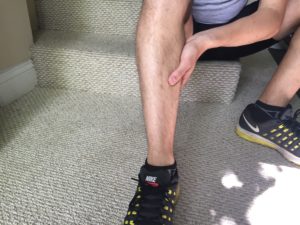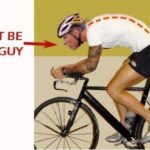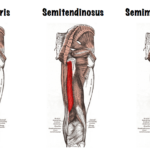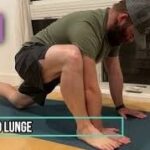Shin splints are a common sports injury, especially amongst beginner runners or those starting a new high impact activity. Maybe you’ve had them at some point: it is a pain in the lower leg, along the inner part of the tibia.In spite of the fact that they are so common, there isn’t a clear histological description of shin splints. However, in most cases, conservative treatment seems to be effective, and there are known preventive measures that work.
Definition
When the term was originally coined, shin splints referred to any pain in the lower leg. Now, there are multiple diagnosis for shin pain and the term shin splints is generally reserved for Medial Tibial Stress Syndrome (MTSS).
MTSS creates pain in the inner part of the shin, along the Tibial bone. It is usually spread over at least 5 cm (2 in) and there may or may not be swelling involved. There is no consensus on the physiopathology of shin splints, some saying that it is caused by micro-tears in the soft tissue attaching to the Tibia (Tibialis Posterior muscle, Soleus, or Interosseus Sheath), others say it’s periostitis (inflammation of the connective tissue that surrounds the bone), while others believe it is the bone itself that is overloaded, resorbing itself faster than it forms.
Risk factors

Shin splints are a sports injury linked to overuse.
Extrinsic risk factors include:
- Repetitive high impact sports (running, gymnastics, basketball, …)
- Over-training
- Sudden increase in intensity or distance
- Less running experience
- poor or hard running surfaces
- improper footwear
Intrinsic risk factors include:
- Over-pronation of the foot (flat feet)
- Women are at higher risk
- Past shin splints
- Being overweight or having weak calves may be contributing factors
Treatment
- Rest for several weeks from the activity that causes pain. Gradually return to that activity after being completely pain-free.
- Pain relievers or anti-inflammatory medication may be advised by your doctor.
- Compression such as compression socks or calf sleeves help relieve symptoms.
- Icing the area participates in decreasing inflammation and provides pain relief. Ice 20min several times a day.
Note: some compression sleeves have pockets for ice so that compression and icing can be combined in one step [11].
- Massage: a massage therapist will loosen the lower leg muscles and eliminate knots to decrease the load on the tibia. Work will be focused on the calf and the Tibialis Posterior. The session will include deep tissue massage, cross fiber friction and stretching to those muscles. Care will be taken to avoid the bone itself, so as not to aggravate it or the insertion points of soft tissue. At the end of a massage session, your therapist will recommend self-care exercises that may include:
- Self massaging the calves with a foam roller (see photo A, below)
- Self massaging the Tibialis Posterior with your thumb (see photo B, below)
- Gastrocnemius (superior and more superficial part of the calf) stretching (see photo C, below)
- Soleus (deeper part of the calf) and Tibialis Posterior stretching (see photo D, below)
(A) Place your calf on the foam roller, with the other leg on top. Lift your hips and roll your calf up and down the foam roller, as well as side to side.

(B) Use your thumbs to massage the soft tissue by the tibia. Apply circular motions for 2-3 minutes with medium pressure.
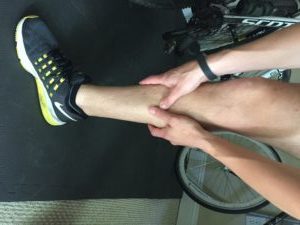
(C) Place the front part of your foot on the edge of a stair and let the heel fall, stretching the calf. Your knee is straight.
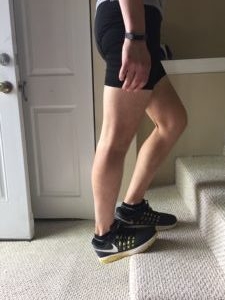
(D) Place the front part of your foot on the edge of a stair and let the heel fall, stretching the calf. Your knee is bent.
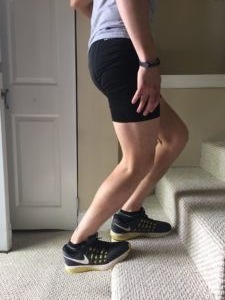
Prevention
- Changing shoes: while advocates of barefoot running claim it is helpful for shin splints, there is no evidence to support this. On the contrary, using arch supports or changing to shock-absorbing insoles seems to be a more effective way to prevent shin splints. [4]
- Gradual increase in work-load: make sure to follow a training program adapted to your level and to increase intensity gradually. If you miss several weeks of training, don’t “jump” to where you should be or do a lot to make up for the missed weeks, but rather build progressively from where you are.
- Cross training: a balanced fitness regimen consists of 3 components: cardio, strength and stretching:
- Cardio: consider switching one or more of your high impact workouts for another cardio workout that is less stressful on your Tibia. For instance, a runner may consider switching one of his/her runs for cycling or swimming.
- Strength: strengthening your leg muscles with exercises such as squats and lunges will help provide support to your lower leg structures. One-legged exercises or exercises on an uneven ground (such as on a Bosu ball) will target more specifically the lower leg stabilizers. A physical therapist might also prescribe targeted Tibialis Anterior (see photos E and F, below) (this muscle is at the front of the lower leg – strengthening it will counter-balance tight calves) or calf strengthening exercises (strong calves protect the Tibial bone).
- Stretching the lower leg muscles will decrease their tightness and the appearance of knots: stretch your calves and Tibialis Posterior, actively before an activity, passively after.
- Massage therapy: regular massage sessions can help keep muscles loose as a preventive measure.
(E) (F) Place your back against a wall, your feet away from the wall. Lift your toes so as to contract the Tibialis Anterior, then place on the floor. Repeat 10 times and do 3 sets.

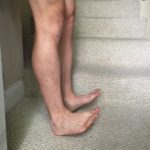
For runners, I recommend heading to Philadelphia Runner [12] to purchase appropriate footwear. All the staff are experienced runners who will be able to assess your gait and provide adequate shoes. They also created Team Philly [13] (for which Phila Massages is a partner) that offers training programs, weekly group runs, running questions support, access to a Physical Therapist, …
Other shin pains
Some practitioners may consider only MTSS to be shin splints, others may use the term for other conditions, some of which are described below, while others still may use the terms “true”/”false” or “anterior”/”posterior” shin splints depending on the shin pain – there currently is no medical consensus on the term “shin splints”.
Chronic compartment syndrome
This condition is rare: pain is usually located in the front part of the shin. It is caused by bleeding or inflammation of the lower leg muscles. These muscles are encased in a tough fascia and if that fascia is too tight, these changes increase the pressure in that area, causing pain. Pain decreases when stopping exercise, numbness can occur. Treatment is similar to that of MTSS except the target muscles/areas will differ.
Note: acute compartment syndrome is very rare and is caused by dangerous pressure elevation in the lower leg. In this case, the pain is acute, increases, and doesn’t go away after rest: it is a medical emergency.
Tendonitis
Tendonitis is an inflammation of a tendon: Tibialis Posterior, Tibialis Anterior or Peroneus can be culprits. Treatment is similar to that of MTSS except the target muscles/areas will differ.
Stress fractures
A differential diagnosis for shin splints may be a stress fracture, which is a small crack in the Tibia. Pain is not spread, can be pinpointed to a specific area, and doesn’t improve after treatment recommended for the above conditions. It is diagnosed by an MRI (though doctors might choose not to do this expensive imaging and diagnose only by a clinical evaluation) and generally requires a boot for 6-8 weeks.
Because there is no consensus on the definition and etiologic factors contributing to shin splints, treatment can be challenging, stressing the importance of prevention. If you think you have shin splints, and as with any other sports injuries, make sure to see your doctor first. Then, if it’s appropriate, the Phila Massages team will be able to help you with your recovery or for prevention.
References (retrieved 5/20/16):
- http://link.springer.com/article/10.2165/00007256-200939070-00002
- http://www.legalpointer.net/healthtopics.php?&A=&I=&article=445941
- http://www.podiatryinstitute.com/pdfs/Update_2015/2015_21.pdf
- http://orthoinfo.aaos.org/topic.cfm?topic=A00407
- http://orthoinfo.aaos.org/topic.cfm?topic=A00204
- http://publications.amsus.org/doi/abs/10.7205/MILMED.171.1.40
- http://youtu.be/WIQsLfFQSQ0
- http://www.sportsinjuryclinic.net/sport-injuries/ankle-achilles-shin-pain/shin-splints/shin-splints-stretching-exercises
- http://www.drpribut.com/sports/spshin.html
- https://runnersconnect.net/running-injury-prevention/the-ultimate-guide-to-shin-splints-for-runners/
- An example of Compression and icing gear (I found this while doing a search on Amazon – I have not personally tried it and am inserting the link to illustrate the type of product mentioned): 110 Percent Play Harder Double Life Shin/Calf Compression Sleeves + ICE for Shins and Calves, Black, Size 1, X-Small https://www.amazon.com/dp/B004M63Y7Y/ref=cm_sw_r_cp_api_QYhpxbEY5Z55B
- Philadelphia Runner: http://philadelphiarunner.com/
- Team Philly: http://www.meetup.com/TeamPhilly/
This article/video is for educational purposes only; do not attempt without your physician’s clearance. If you are in pain or injured, see your physician.
Copyright © Vidal Sports LLC 2018




